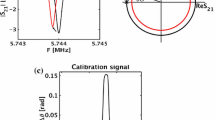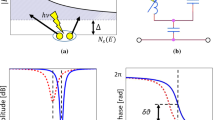Abstract
The kinetic inductance detector (KID) is a cutting-edge superconducting detector. The number of KID developers is growing. Most of them have switched from their previous study to superconducting technologies. Therefore, infrastructures for the fabrication of KIDs and cooling systems for their tests have already been established. However, readout electronics have to be newly prepared. Neither a commercial system nor low-cost standard electronics are available despite various attempts to create a standard one. We suggest the use of RedPitaya as readout electronics for the initial step of KID development, which is low cost (\(\approx \)400 USD) and easy to set up. The RedPitaya consists of an all-programmable FPGA-CPU module and a dual-channel 14 bit DAC (ADC) to generate (measure) fast analog signals with 125 MSpS. Each port can be synchronized in-phase or quadrature-phase, and functions for generating and sampling analog signal are prepared. It is straightforward to construct vector network analyzer-like logic by using a combination of these default functions. Up-conversion and down-conversion of its frequency range are also possible by using commercial equipment, i.e., mixers, couplers, and a local oscillator. We implemented direct down-conversion logic on the RedPitaya, and successfully demonstrated KID signal measurements.







Similar content being viewed by others
References
P.K. Day et al., Nature 425, 817–821 (2003)
J. Zmuidzinas, Annu. Rev. Cond. Mater. Phys. 3, 169–214 (2012)
S. McHugh et al., Rev. Sci. Instru. 83(4), 044702 (2012)
O. Bourrion et al., J. Instrum. 7, 7014 (2012)
Acknowledgments
We thank Makoto Minowa for giving the environment for this study. This work is supported by Grants-in-Aid for Scientific Research from the Ministry of Education, Culture, Sports, Science, and Technology, Japan (KAKENHI Grant Nos. 23684017, 25610064, 26105519, 26247045, 14J10972, 15H05448, and 15H05743). We also acknowledge Advanced Leading Graduate Course for Photon Science (ALPS), and the Basic Science Research Program through the National Research Foundation of Korea (NRF) funded by the Ministry of Education, Science, and Technology (Grant No. 2013R1A1A2004972).
Author information
Authors and Affiliations
Corresponding author
Rights and permissions
About this article
Cite this article
Tomita, N., Jeong, H., Choi, J. et al. World’s Cheapest Readout Electronics for Kinetic Inductance Detector by Using RedPitaya. J Low Temp Phys 184, 443–448 (2016). https://doi.org/10.1007/s10909-016-1485-0
Received:
Accepted:
Published:
Issue Date:
DOI: https://doi.org/10.1007/s10909-016-1485-0




